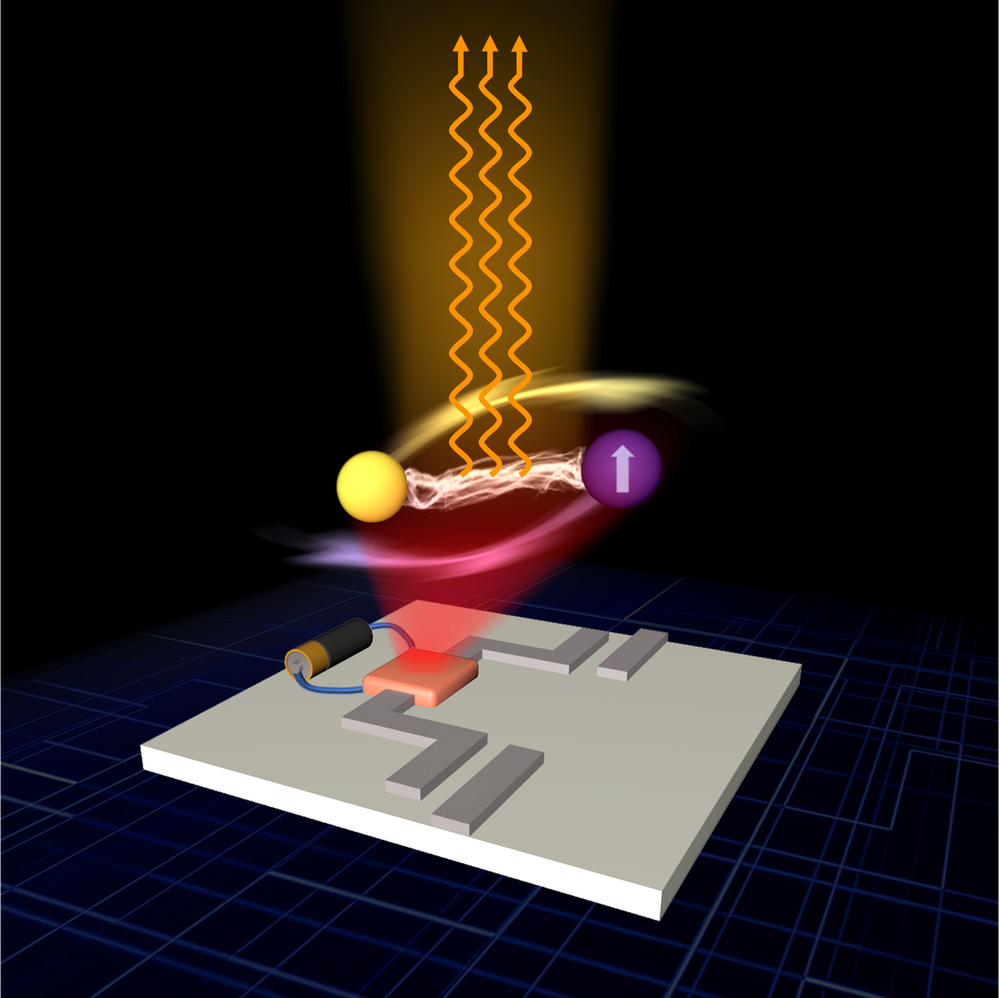High-Power, Room-Temperature, Coherent Microwave Source
One of the challenges for building systems for quantum computing and communications has been the lack of laser-like microwave sources that produce sufficient power but don’t require extreme cooling. Now a research team has demonstrated a new room-temperature technique for making coherent microwave radiation—the kind that comes from a laser [1]. The device exploits the interaction of a magnetic material with electromagnetic fields. The researchers expect that the work will lead to microwave sources that can be built into chips employed in future quantum devices.
The devices that store quantum bits for quantum computers often require microwave signals to input and retrieve data, so lasers operating at microwave frequencies (masers)—and other sources of coherent microwaves—could be very useful. But even though masers were invented before lasers, most maser technologies work only at ultracold temperatures. A 2018 design works at room temperature but doesn’t produce very much power [2].
In 2015, inspired by the superior performance of a new class of lasers called polariton-exciton lasers, Can-Ming Hu of the University of Manitoba, Canada, wondered about extending the technology to the microwave regime. These devices exploit the interaction of light with excitons, which are short lived electron-hole pairs. The interaction occurs inside an optical cavity, a space where light waves reflect back and forth many times. The technique “had transformed optical laser technology, and I was curious whether a similar approach using magnetic excitations might help us produce better microwave sources,” Hu says.
Now, after seven years of basic research, he and his colleagues believe that they have succeeded. Their scheme causes photons in a microwave cavity to interact with electron spins in a magnetic material. In the presence of a magnetic field, these spins and photons together create hybrid excitations called magnon polaritons, which in turn generate coherent microwaves. The technique produces this coherent radiation using a concept different from that of a maser. A key focus of Hu and his colleagues’ recent work was understanding how they could amplify the radiation in the cavity so as to generate significant microwave energy while still exerting precise control over the frequency and other properties.
The researchers knew that the polaritons could in principle generate useful microwaves. But a key focus of Hu and his colleagues’ recent work was understanding how they could amplify the radiation in the cavity so as to generate significant microwave energy while still exerting precise control over the frequency and other properties.
To demonstrate the effect, the researchers used a standard type of microwave cavity, a 1.2-mm-wide strip of composite glassy material that confines strong fields to a region just above its surface. They placed a 1-mm-diameter sphere of yttrium iron garnet, a magnetic material, on this surface and turned on a static magnetic field. The alignment of electron spins in the sphere then rotated around the magnetic-field direction. A transistor connected to the strip provided the amplification of the microwave fields, but the fields also lost energy to dissipation in a way that the researchers had carefully arranged. The presence of the sphere in the cavity induced the interaction between spins and photons, creating magnon polaritons, as the researchers were able to verify by measuring the absorption of microwaves of various frequencies that they directed into the region. The results showed clear absorption features indicating that the independent oscillatory modes of the cavity and of the magnons had combined to create polaritons.
They then demonstrated that these polaritons could generate coherent microwave radiation with a peak frequency of 3.6 GHz and a linewidth of only 360 Hz. This sharp frequency definition, Hu says, is remarkable for a magnetic system, and the linewidth is 1000 times smaller than that of the best alternative microwave sources based on magnetic technologies. (Nonmagnetic sources often have superior properties but usually require low temperatures.) In addition, the magnon-polariton device’s output is a billion times more powerful than the 2018 room-temperature maser. The researchers also demonstrated an ability to amplify an input microwave signal by 10,000 times while preserving the quality of the signal. The possibilities for this amplification function “are beyond our imagination,” Hu says.
“I am excited by the beautiful results reported here,” says Luqiao Liu, a specialist in nanoscale magnetic systems at the Massachusetts Institute of Technology. “The use of magnon polaritons opens up many new possibilities and, surprisingly, achieves superior performance in generating microwaves [in comparison with] many existing alternative technologies.”
–Mark Buchanan
Mark Buchanan is a freelance science writer who splits his time between Abergavenny, UK, and Notre Dame de Courson, France.
References
- B. Yao et al., “Coherent microwave emission of gain-driven polaritons,” Phys. Rev. Lett. 130, 146702 (2023).
- J. D. Breeze et al., “Continuous-wave room-temperature diamond maser,” Nature 555, 493 (2018).





